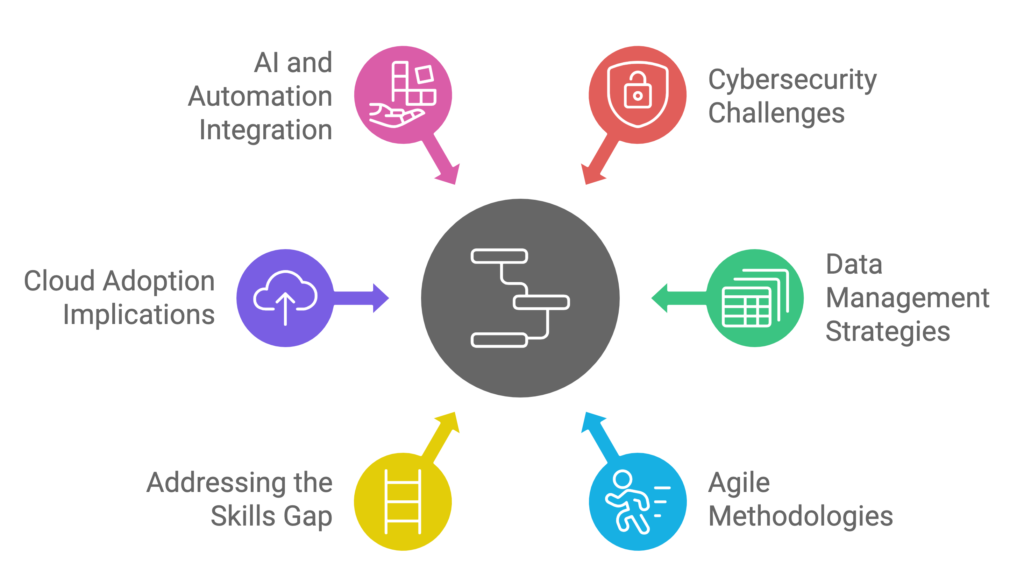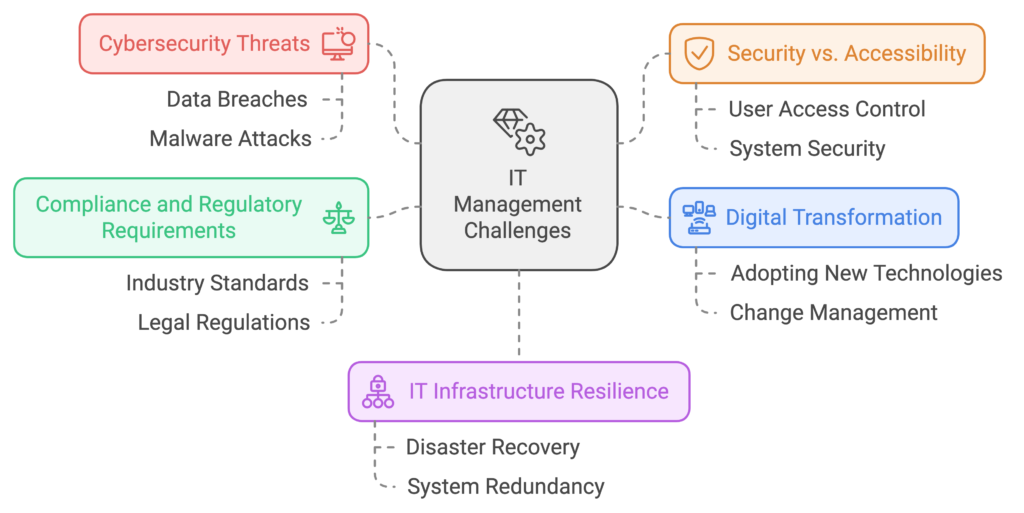The Importance of IT Management in a Fast-Paced Technological Landscape
In the fast-paced world of technology, staying ahead of the curve is imperative for businesses to thrive. Effective IT management is the cornerstone of success in a rapidly changing landscape. As technology evolves at breakneck speed, companies must adopt agile strategies to adapt and innovate. This necessitates a comprehensive approach integrating cutting-edge solutions, proactive risk management, and seamless collaboration across departments. By leveraging the right tools and frameworks, IT leaders can optimize operations, enhance cybersecurity measures, and drive digital transformation. Embracing cloud computing, automation, and data analytics are just a few key components of modern IT management. This dynamic environment requires a forward-thinking mindset and a willingness to embrace change. In this guide, we will explore the strategies and best practices that empower organizations to navigate the complexities of IT management amidst constant change.
Understanding the Changing IT Landscape
It is crucial to stay abreast of the ever-evolving IT landscape. This blog section will delve deeper into the key factors that are driving the rapid changes in the IT landscape and will explore the profound impact of emerging technologies on IT management.

Technological Advancements
The continuous advancements in technology, such as artificial intelligence, cloud computing, and the Internet of Things, are reshaping and revolutionizing the IT landscape. Companies must not only adapt but also innovate, leveraging these advancements to stay ahead in the competitive market.
Cybersecurity Challenges
With the rising number of cyber threats, cybersecurity has indisputably become a paramount concern for IT management. Staying informed about the latest security trends is crucial. Consistently implementing robust cybersecurity measures is imperative to safeguarding sensitive data and ensuring business continuity.
Data Management Strategies
The exponential growth of data in today’s digitized world presents both challenges and opportunities for IT professionals. Establishing effective data management strategies is crucial for organizations. These strategies are essential for harnessing the power of data analytics and driving informed business decisions.
Agile Methodologies
The agile approach has revolutionized and become the norm in software development and project management. Embracing agility empowers IT teams to swiftly adapt to changing requirements, foster innovation, and enhance collaboration.
Addressing the Skills Gap
The rapid evolution of the IT landscape has resulted in a noticeable skills gap, particularly in emerging technologies. Continuous learning, upskilling, and reskilling are essential for IT professionals to stay competitive in the digital era. These processes help them meet the demands of an ever-evolving technological landscape.
Cloud Adoption Implications
Cloud computing offers unparalleled scalability, flexibility, and cost-efficiency. Understanding how cloud adoption affects IT infrastructure and operations is crucial for organizations looking to improve performance and efficiency. It’s essential for optimizing processes and staying competitive in today’s digital landscape.
AI and Automation Integration
Artificial intelligence and automation are not merely trends but transformative technologies revolutionizing IT operations. They empower predictive maintenance, enable intelligent decision-making, and enhance operational efficiency, providing a competitive edge in the digital landscape.
The impact of emerging technologies on IT management is profound and far-reaching. IT leaders must proactively monitor industry trends, evaluate new technologies, and adapt their strategies to navigate the evolving IT landscape successfully, ensuring sustainable growth and innovation.
Challenges Faced by IT Management
IT management plays a crucial role in ensuring the efficient operation of businesses. However, IT managers encounter various challenges that can impede their success. Let’s delve into some of the common hurdles faced by IT management professionals.

Identifying Common Challenges Faced by IT Managers
IT managers often grapple with a myriad of issues that hinder productivity and innovation within their organizations. From budget constraints to talent shortages, it is essential to recognize and address these challenges effectively.
Dealing with Cybersecurity Threats and Data Privacy Issues
In an era marked by increasing cyber threats and stringent data protection regulations, IT managers face the daunting task of safeguarding their company’s digital assets. From ransomware attacks to data breaches, the need for robust cybersecurity measures has never been more critical.
The fast-paced evolution of technology poses additional challenges for IT management. Staying updated with new trends such as cloud computing, artificial intelligence, and the Internet of Things requires continuous learning and adaptation. Integrating these technologies with existing legacy systems is a complex task, demanding careful strategic planning and foresight.
Moreover, IT managers must navigate the complexities of vendor management and service-level agreements to ensure seamless operations. Maintaining strong vendor relationships, negotiating contracts, and monitoring service quality are integral to effective IT management.
In IT project management, challenges often arise from scope creep, resource allocation, and timeline constraints. IT managers must possess strong project management skills to successfully oversee initiatives from inception to completion while adhering to budgetary and timeline constraints.
Additionally, the importance of fostering a culture of innovation and continuous improvement within the IT department cannot be overstated. Encouraging creativity, collaboration, and knowledge sharing among team members fosters a dynamic work environment that fuels technological advancements and drives organizational success.
By understanding and proactively addressing these multifaceted challenges, IT management can enhance operational efficiency, mitigate risks, and drive business growth in a rapidly evolving technological landscape.
Balancing Security and Accessibility
One of the ongoing challenges for IT managers is striking the right balance between security measures and accessibility. While it’s crucial to protect sensitive data and systems from cyber threats, overly restrictive security protocols can hinder user experience and productivity. Finding the optimal equilibrium between security and accessibility is a continuous process that requires constant evaluation and adjustment.
Managing Digital Transformation
As organizations increasingly embrace digital transformation initiatives, IT managers oversee complex transitions to modernized infrastructures and processes. Adopting cloud-based solutions, implementing automation technologies, and integrating digital tools across departments are essential to successful digital transformation. IT managers must navigate the challenges of change management, training employees on new technologies, and ensuring seamless integration to maximize the benefits of digital initiatives.
Addressing Compliance and Regulatory Requirements
In an environment where data privacy regulations are becoming more stringent, IT managers must stay abreast of evolving compliance requirements. To avoid penalties and reputational damage, it’s crucial for IT systems and practices to align with industry standards and legal mandates. Collaboration between IT managers and legal and compliance teams is essential to create and enforce policies that protect sensitive data and uphold regulatory obligations.
Enhancing IT Infrastructure Resilience
In light of the growing number and sophistication of cyber attacks, IT managers have a crucial role in strengthening the resilience of their IT infrastructure. This involves implementing strong backup and disaster recovery plans, conducting regular security assessments, and fortifying network defenses to reduce the risk of disruptions and data loss.IT managers must proactively identify vulnerabilities in their infrastructure and implement proactive measures to mitigate risks and ensure business continuity.
The field of IT management is always evolving, requiring proactive problem-solving, strategic planning, and continuous adaptation to address the various challenges brought on by technological advancements and evolving business landscapes. By addressing these challenges directly and fostering a culture of innovation and collaboration, IT managers can lead their organizations to success, minimize risks, and capitalize on the opportunities presented by the digital age.
Effective Strategies for IT Management
Effective IT management is crucial for organizations to stay competitive and secure. Implementing the right strategies can help streamline operations, enhance productivity, and drive innovation. Let’s explore some key strategies that can empower IT management teams to navigate the complexities of the digital landscape:

Embracing Agile Methodologies:
Incorporating agile methodologies is essential for IT management to adapt to changes quickly. To effectively address changing market demands and customer requirements, organizations can break projects into smaller, achievable tasks and foster teamwork among team members. Additionally, agile methodologies improve operational efficiency and cultivate innovation and collaboration within IT departments.
Leveraging Cloud Computing:
Cloud computing offers unparalleled scalability and flexibility, allowing IT departments to efficiently manage resources and infrastructure. By migrating to the cloud, businesses can reduce operational costs, improve accessibility, and enhance data security. Additionally, cloud services provide the agility needed to quickly scale IT resources based on demand, enabling organizations to stay competitive in today’s rapidly changing business landscape.
Prioritizing Cybersecurity Measures and Compliance:
With the rise of cyber threats and data breaches, prioritizing cybersecurity measures is non-negotiable for IT management. Implementing robust security protocols, conducting regular audits, and ensuring compliance with regulations are essential to safeguarding sensitive information and maintaining customer trust. Moreover, staying abreast of the latest cybersecurity trends and technologies is crucial to proactively mitigating risks and protecting organizational assets.
Investing in Employee Training and Upskilling:
Investing in continuous employee training and upskilling programs is key to building a competent IT workforce. By equipping employees with the latest technological skills and knowledge, organizations can foster innovation, improve job satisfaction, and retain top talent. Moreover, investing in employee development not only enhances individual performance but also contributes to the overall success and competitiveness of the organization.
By incorporating these strategies into their IT management approach, organizations can achieve operational excellence, drive growth, and stay ahead of the competition in today’s digital landscape. Embracing agility, leveraging cloud technologies, prioritizing cybersecurity, and investing in employee development are essential components of a successful IT management strategy that ensures long-term success and resilience in an ever-evolving technological landscape.
The Role of IT Leaders in Adapting to Change
The role of IT leaders is more crucial than ever. IT leaders play a pivotal role in driving innovation, facilitating change, and ensuring that organizations remain competitive and agile in the face of constant disruption. Let’s delve into the key aspects of the role of IT leaders in adapting to change.
-
Empowering IT Leaders to Drive Innovation and Change
One of the primary responsibilities of IT leaders is to spearhead innovation within their organizations. They are tasked with identifying emerging technologies, assessing their potential impact, and strategically implementing them to drive business growth. To effectively adapt to change, IT leaders must be empowered to take calculated risks, experiment with new ideas, and lead their teams toward embracing a culture of innovation.
Encouraging a Culture of Continuous Learning and Improvement
In a dynamic environment where technology trends evolve rapidly, continuous learning is paramount. IT leaders must foster a culture of continuous learning and improvement within their teams to ensure that they stay updated with the latest developments in the industry. By encouraging ongoing training, certifications, and knowledge sharing, IT leaders can equip their teams with the skills and expertise needed to adapt to change effectively.
The Role of IT Leaders in Strategic Decision-Making
In addition to driving innovation and fostering a learning culture, IT leaders also play a crucial role in strategic decision-making. They are responsible for aligning technology initiatives with business goals, optimizing IT processes for maximum efficiency, and ensuring that IT investments deliver tangible results. By leveraging data analytics, IT leaders can make informed decisions that drive organizational success and facilitate adaptability in a rapidly changing environment.
Building Resilient IT Infrastructure
Another essential aspect of the role of IT leaders in adapting to change is building resilient IT infrastructure. As organizations face increasing cybersecurity threats and disruptive technologies, IT leaders must prioritize cybersecurity measures, disaster recovery planning, and robust infrastructure to ensure business continuity. By investing in scalable and secure IT systems, IT leaders can mitigate risks, respond to challenges effectively, and maintain operational continuity in the face of unforeseen disruptions.
Creating Cross-Functional Collaboration
Collaboration across departments is key to successfully navigating change. IT leaders must foster cross-functional collaboration by breaking down silos, encouraging communication between teams, and promoting a shared vision of innovation and adaptability. By fostering a collaborative environment where different departments work closely together, IT leaders can drive synergies, streamline processes, and accelerate the pace of change within the organization.
The role of IT leaders in adapting to change is multifaceted and critical to the success of modern organizations. By empowering IT leaders to drive innovation, encouraging continuous learning, making strategic decisions, building resilient IT infrastructure, and promoting cross-functional collaboration, businesses can effectively adapt to change, embrace new opportunities, and thrive in a rapidly evolving digital landscape.
Conclusion
In a rapidly changing IT landscape, adopting proactive strategies is essential for effective IT management. By prioritizing continuous learning, fostering a culture of adaptability, leveraging innovative technologies, and maintaining strong communication channels, organizations can navigate challenges and seize opportunities in the dynamic digital environment. Embracing change as a constant, IT leaders can steer their teams toward success and ensure sustainable growth in today’s ever-evolving technological world.





